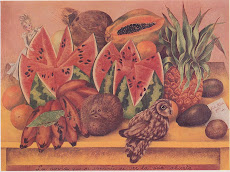Dear Ian et al, thanks of course for the invitation. Apologies for an abbreviated response as we have been traveling, exploring food-worlds sans-laptops. We write this from the top of our heads, as the saying goes (… and/or maybe from our guts?)
We were pleased to read Rachel Slocum´s comment on our AAG paper. We are indeed focusing our attention on engaging with bodies. Inspired by Probyn´s (2000) use of the term, along with several other feminist scholars’ conceptions of bodies and embodiment (e.g. Grosz 1994, McWhorter 1999, Brison 2001, Alcoff 2006), we have been playing around with notions of the visceral. We find it exciting that others are also finding intrigue with the term. For instance, Mike Goodman´s comment in this blog (and in Goodman 2008) that,
The viscerality of food is about its connections—inside, outside, gender, sexuality, et al—but also how food contains the emotional (e.g. one’s stomach on one’s sleeve), the inexpressible, and the biological and how these are all inseparable and entangled in complex, complementary and ambiguous ways.
Although we might use different language, this comment resonates with what we have been exploring through empirical work with particular food-based eco-social projects such as those of the Slow Food movement and school garden and cooking programs. Through this work we have been trying to specify what it means to study the nebulous ¨viscerality of food¨ that Goodman mentions. It is quite obvious that we connect to food viscerally, and more that multiple visceralities of food exist (perhaps even within the same body). The pressing task for us has been how to actually apprehend these visceralities, how to conduct empirical work on the interpersonal (ever-relational) ways in which bodies feel food. We see this as politically important for a number of inter-connected reasons. In the visceral realm, foods link up with ideas, memories, sounds, visions, beliefs, past experiences, moods, worries and so on, all of which combine to become material – to become bodily, physical sensation. If we can understand such sensation – how it forms, what it does to the body, how it can be shaped – then we might be able to understand and utilize food’s differential power to affect bodies.
We can also use this insight to understand social difference more completely; we can begin to discuss difference not so much in terms of constructed identities but rather in terms of fluid visceralities. A visceral conception of difference does much to illuminate the inherent complexity to the “categories” of race, class and gender. In terms of the critiques of whiteness and eliteness within alternative food, with visceral difference we too find that there is [always] more to say (as Slocum notes in this blog). We see this “more-ness” as a result of the material realities of bodies themselves; not only do (minded) bodies develop seemingly static habits of being, but bodies are also always changing and changeable in contest with these (socially recognized and labeled) stases. Academic work on these subjects must therefore recognize and make room for such changability, and must furthermore encourage movement in progressive directions. By understanding how “tendencies and latencies” towards particular visceral sensations develop via bodily relation with food, we can begin to more fully comprehend the patterns, inequities, habits, preferences, and opportunities that have developed around alternative food. In so doing, we can begin to sense what it would take for all kinds of different people to gain the capacity to feel food (and eat food) in other (i.e. alternative/ transgressive) ways. This ability for individuals and groups to sense/imagine/taste different bodily futures – to develop what we have been terming in shorthand as alternative “visceral imaginaries” – is a critical but heretofore under-discussed part of feminist empowerment and self-determination (as discussed, for example, by hooks 2004). Thus, as wary as we are of the oft-noted exclusiveness of alternative food, we are also optimistic about the (admittedly chaotic!) potentials for change that accompany visceral connections to food. We hope that academic work in this domain will lead to increased equity and justice within alternative food.
--Allison and Jessica Hayes-Conroy
Alcoff, Linda Martin (2006) Visible Identities: Race, Gender, and the Self, Oxford: Oxford University Press
Brison, S. (2002) Aftermath: Violence and the Remaking of a Self, Princeton: Princeton University Press
Goodman, M. (2008) Towards visceral entanglements: Knowing and growing the economic geographies of food. in R. Lee, A. Leyshon, L. McDowell & P. Sunley (eds) A compendium of economic geography. Sage, London
Grosz, E. (1994) Volatile Bodies: Toward a Corporeal Feminism, Bloomington: Indiana University Press
hooks, bell (2003) Rock my Soul: Black People and Self-Esteem, Atria Books, New York
McWhorter, L. (1999) Bodies and Pleasures: Foucault and the Politics of Sexual Normalization, Bloomington: Indiana University Press
Probyn, E. (2000) Carnal appetites: Food, sex, identities. London: Routledge.

1 comment:
Allison and Jessica's paper on 'feminism, food and visceral politics' has just been published in Gender, place and culture: see left for reference.
Post a Comment